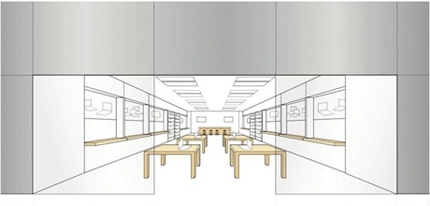
In a recent preliminary ruling, the Court of Justice of the European Union (CJEU) ruled on the registrability of the appearance of Apple’s store design.
Back in November 2010, Apple successfully obtained from the United States Patent and Trademark Office (USPTO) the registration of a three-dimensional trade mark consisting of the representation, by a design in colour (in particular, metallic grey and light brown), of its flagship stores. The sign was the following:

On the basis of the US trademark, Apple then went on to file an international registration designating several countries, including Germany, where the German IP Office (DPMA) refused to register the extension of the three-dimensional international trade mark. The DPMA argued that the depiction of the space devoted to the sale of the company’s products was nothing more than a mere representation of an essential aspect of that company’s business. Pursuant to Apple’s appeal, it was for the competent German court to decide on the matter, but the court chose to stay its proceedings and refer certain questions to the CJEU concerning the interpretation of the applicable European trade mark directive (Directve 2008/95/EC)
In its judgment brought in July 2014, the CJEU found that under European trade mark directive, the representation, by a design alone, without indicating the size or the proportions, of the layout of a retail store, may indeed be registered as a trade mark for services (consisting in services relating to the relevant goods). At the same time, the CJEU emphasized that the given design must not form an integral part of the offer for sale of the relevant goods and the sign has to be capable of distinguishing the services of the applicant. Finally, the CJEU also noted that in order to be registered, none of the grounds for refusal set out in the European trade mark directive may apply.
The CJEU’s judgment has important practical ramifications in potential disputes concerning similar trade marks:
The response to these questions will rest with the courts in the EU Member States (including Hungary) and possibly, the CJEU, who will have to tackle these issues in upcoming individual trade mark disputes.